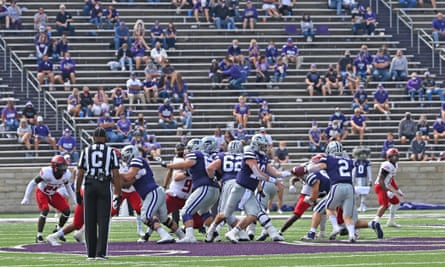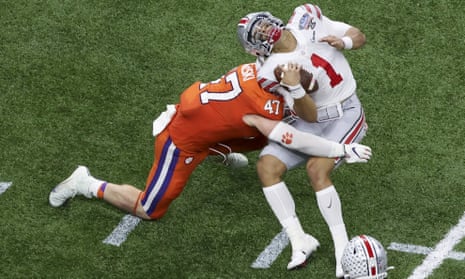At half-time of the national college football semifinal between Clemson and Ohio State, OSU coach Ryan Day said something that encapsulated everything wrong with the 2020 college football season, though it had nothing whatsoever to do with Covid-19.
He confidently told a national television audience that his star quarterback Justin Fields, who had just suffered a nasty rib injury, was that “he’s gotta play for 30 more minutes.” Fields did not receive an X-ray at half-time and returned to play in the second half. For his part, Fields said medical staff “didn’t really give me a diagnosis,” although he did receive multiple shots to get him through the game. He also said, “Even throwing 10 yards, it would hurt.” Day would receive $100,000 as a bonus for Ohio State’s victory over Clemson – and his team will play Alabama for the national title on Monday night. Fields, on the other hand, received no compensation at all.
Day’s comments encapsulate everything you need to know about a season and sport predicated on almost unbelievable levels of harm and exploitation.
Long before the first play in either a hauntingly vacant or horrifyingly packed stadium, the sport’s premier conference had already telegraphed how all of this would go. In a leaked call the SEC held with player representatives prior to the season, a league official told players: “We’re going to have [Covid-19] cases on every single team in the SEC. That’s a given. And we can’t prevent it.” That official might as well have been Nostradamus, because that’s exactly what was about to happen. 139 FBS games were cancelled or rescheduled because of significant numbers of infections on participating teams. An additional 19 bowl games were cancelled due to the pandemic.
All of this occurred in the context of a jarring series of events. While many universities across the US turned to virtual learning to protect one source of revenue – tuition fees – they did the exact opposite in ordering football players to porous campus ‘bubbles’ to protect another: football. Meanwhile, football conference officials resorted to elaborately angsty performances of concern. Big Ten commissioner Kevin Warren said that he “knelt on the floor and prayed for guidance,” about whether to go ahead with the season (he ultimately did). Meanwhile, Pac 12 commissioner Larry Scott made a show of meeting with players of the #WeAreUnited movement to discuss their health concerns in a conversation that conference representatives characterized as “productive”. Yet, players said the commissioner had referred to their activism as a “misguided PR stunt.” The Pac 12 too would ultimately proceed with the season, ignoring players in their return protocols, and dismantling any labor organization in the process.
The fact that the season took place at all was shaped by the assumption that very few people with the age and conditioning of college football players have died from Covid-19. While this understanding is belied to some degree by the tragic deaths of California University of Pennsylvania football player Jamain Stephens and Appalachian State University student and former North Carolina high school basketball star Chad Dorrill, most players have, of course, survived. Beyond this, how many people not on the playing field – such as training staff, bus drivers and stadium workers – have been exposed because they are instrumental to gamedays?
Indeed, Dr Angela Rasmussen, virologist and affiliate of the Georgetown Center for Global Health Science, told us, “When universities opened in the summer/fall, conditions inherent to college life immediately resulted in large outbreaks on many college campuses, including outbreaks that spread through college football teams. University administrators blamed the students and athletes, when in reality they failed to create safe conditions for the entire campus community. It’s not a stretch to think some people who ended up returning home to their own communities resulted in further spread.”
Rasmussen added: “I’ve found it hard to watch the NFL this year … I’ve found it impossible to watch college football because not only are there fewer precautions and less access to testing at many schools, but also because many of them allow up to 25-30% capacity at games, with tailgating, lax mask usage, etc. These are very unsafe conditions for all the people involved, and in no way justifiable by saying we ‘need’ it.”
Yet, the razor-narrow focus on death distracts us from the far more pervasive forms of physical harm that can result from this virus, including long Covid, extensive harm to the lungs, brain damage, and a heart inflammation known as myocarditis. In fact, in a JAMA Cardiology study of college athletes who had contracted Covid-19, 15% of those examined were found to have myocarditis and an additional 30% had signs of prior myocardial injury. Even before this pandemic, myocarditis was responsible for the deaths of approximately 75 athletes a year between the ages of 13-25. As Rasmussen told us: “We do know that around 30% of people report some form of long Covid, but we don’t know much at all about how long it lasts. However, some people with myalgic encephalomyelitis/chronic fatigue syndrome associated with a viral infection can suffer for decades. People with acute lung injury after having [Covid-19] have reported that they have still not regained full function after recovering.”
That being said, none of the risks above is as dangerous to college football players as the one that perpetually stalks the sport: chronic traumatic encephalopathy (CTE). CTE, which cannot be diagnosed in the living, is a consequence of the repeated head impacts associated with football. It presents with a range of symptoms ranging from depression, anxiety, memory loss, and mood swings to suicidal ideation and actions. A Boston University study into the brains of deceased former football players found evidence of CTE in 99% of former NFL players and 90% of former college players. While Day’s half-time comments on the surface have very little to do with coronavirus, they epitomize the risks that unpaid college athletes are expected to, neigh compelled to, accept as part of day-to-day life. But how do athletes themselves experience this?

We talked to four players about their experiences of exploitation and harm over the past few months of a season that magnified everything problematic about college football.
Given the general physical toll of the sport, preparation is the bare minimum needed to mitigate the wear of a season. Yet, an ACC player told us that because of the uncertainty around the start of the season, preparation time was actually minimized: “This season has been very tough due to Covid-19. Having our offseason cut short caused us to try and work double time in the couple of months we did have leading up to the fall. Overall I feel like our team did everything we can with the time we had, but it was not enough to prepare for the rigors of a fall football season.”
In fact, it was just such a sense that corners were being cut that led another athlete we spoke to, who opted-out of the season, to suggest that the failure to prioritize health led to profound mistrus towards coaches and their universities. He told us, “People either aren’t happy with their current program, or don’t trust their current coach and/or administration after going through this past year under their leadership.”
No doubt, this sense of mistrust was compounded by hypocrisy: that coaches were paid millions and continued living their regular lives, while players were forced to abide by “team bubbles” without even the salve of a wage. An SEC player put it bluntly: “It’s bullshit. I have family and friends too, you know? Coaches are able to go home to their families at night and I have to go back to my dorm on an empty campus. The fact that they wanted us on campus over Christmas is messed up. I love football, but that’s messed up. I want to see my family and friends.”
Indeed, confinement was particularly punitive for athletes supposedly compensated via the frills of the undergraduate experience itself. A Pac 12 player explained that “Everything else that makes being a college athlete worth it is stripped away this year, we’re basically just programmed to show up, play football and go home; it’s taking a toll on everyone. No one wants to be here any more. I think the most frustrating part is hearing all of these people say that they are doing all of this ‘for the athletes’ but I think it’s pretty clear why we are all here.”
The experiences of players like these during this pandemic have reverberated with some of higher education’s most powerful decision makers. Jordan Acker, vice-chair of the board of regents at the University of Michigan told us: “This college football season has finally stripped the veneer away that playing has anything to do with anything other than money. We need to think of college football in a different paradigm, but one that has roots in other parts of higher education: one where those who bring in money for the institution are compensated fairly.
“I’m not suggesting that I have all the solutions for this. I think anyone who does is kind of lying to themselves. But I do think that the fix of it starts with a recognition that we’re what we’re doing isn’t the college athletics of 1985 or 1995, or even 2005. We’re living in a different world and we need to adapt the way we compensate athletes. We have to recognize that things have changed and won’t go back to how they were unless we’re willing to do what the Ivy League does, and treat college athletics like any other student activity.”
Similarly, Michael Hsu, regent at the University of Minnesota, reflected on the season in these terms: “While I did support the pandemic fall football season, if it could be played safely, it is clear now that football players are essential workers. The problem remains that they are not treated as employees and are not compensated. As non-employees, players’ health, safety and well-being are not very well protected. Revolutionary changes beyond just name, image and likeness improvements are required to bring fairness to football and other college sports.”
The player who opted-out was aghast at how readily universities, teams, broadcasters, and fans were able to revel in college football during a pandemic: “These games are fun to watch and they really feel normal, but they’re anything but normal. It’s easy to sit down on your couch and to cave to the fantasy that things are fine, they aren’t. Things are not normal. I have teammates that have spent over a month collectively in quarantine, and I have other teammates that have been notified by medical personnel that they now have heart irregularities. Things are not normal. A Florida basketball player collapsed to the floor on national television. Things are not normal.”
Not normal, that is, except for the fact that the underlying dynamics that made the abnormality of college football during a global health crisis possible were entirely unchanged. This is a sport built on the physical sacrifice of unpaid workers, whether the cost is Covid-19 or traumatic brain injury.
Perhaps above all, the pre-existing condition the pandemic has most forcibly laid bare is how disposable all workers are relative to the thirst for profit, even in higher education. In fact, what we have seen this season is simply the addition of Covid-19 to an ever-growing list of acceptable risks for this class of workers who labor to sustain a system of exploitation that unmistakably favors those who control the purse strings. Ultimately, the case of college football players long subjected to harm on the job demonstrates that in this respect there is nothing particularly novel about this coronavirus.
Nathan Kalman-Lamb is lecturing fellow at Duke University. Derek Silva is an assistant professor of criminology at King’s University College. Johanna Mellis is assistant professor of history at Ursinus College. They co-host The End Of Sport podcast.
